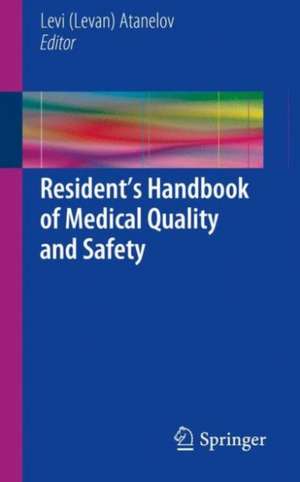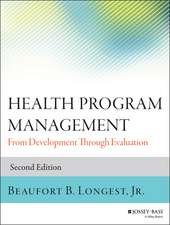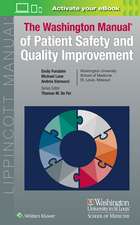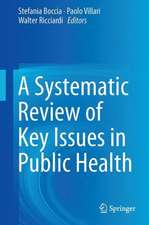Resident’s Handbook of Medical Quality and Safety
Editat de Levi (Levan) Ataneloven Limba Engleză Paperback – 21 apr 2016
Drive to provide high value healthcare has created a field of medical quality improvement and safety. A Quality Improvement (QI) project would often aim in translate medical evidence (e.g. hand hygiene saves lives) into clinical practice (e.g. actually washing your hands before you see the patient, suffice it to say that not all hospitals are able to report 100% compliance with hand-hygiene). All doctoral residents in the United States must now satisfy a new requirement from the American College of Graduate Medical Education that they participate in a QI initiative. However, few departments are equipped to help their residents develop and implement a QI initiative. Resident’s Handbook is a short, not fussy, and practical introduction to developing a QI initiative. Meant not only for residents seeking to jump-start a QI initiative but also for attending physicians looking to improve their clinical practice, residency program directors and even medical students already eyeing what residency training holds for them; the book introduces and explains the basic tools needed to conduct a QI project. It provides numerous real-life examples of QI projects by the residents, fellows and attendings who designed them, who discuss their successes and failures as well as the specific tools they used. Several chapters provide a more senior perspective on resident involvement in QI projects and feature contributions from several QI leaders, a hospital administration VP and a residency program director.
Though originally designed with physicians in mind, the book will also be helpful for physician assistants, nurses, physical, occupational and speech language pathology therapists, as well as students in these disciplines. Since no QI intervention is likely to be successful if attempted in isolation more non-physician clinicians are joining the ranks of quality and safety leadership. Therefore several non-physician clinician led initiatives included in the manuscript constitute an integral part of this book.
The book serves as a short introduction to the field of medical quality improvement and safety emphasizing the practical pointers of how to actually implement a project from its inception to publication. To our knowledge this is the first concise do-it-yourself publication of its kind. Some of the topics covered include: how to perform an efficient literature search, how to get published, how to scope a project, how to generate improvement ideas, effective communication, team, project management and basic quality improvement tools like PDCA, DMAIC, Lean, Six Sigma, human factors, medical informatics etc..
Although no substitute for the services of a trained clinical statistician, chapters on statistics and critical assessment of the medical literature familiarizes residents with basic statistical methodologies, clinical trials and evidence based medicine (EBM). Since no QI project is complete without providing evidence forpost-intervention improvement we provide a short introduction to the free statistical language R, which helps residents independently run basic statistical calculations. Because much of QI involves assessment of subjective human experiences, there is also a chapter on how to write surveys. Resident’s Handbook of Medical Quality and Safety is not an exhaustive QI textbook but rather a hands-on pocket guide to supplement formal training by other means.Preț: 725.03 lei
Preț vechi: 763.18 lei
-5% Nou
Puncte Express: 1088
Preț estimativ în valută:
138.75€ • 144.04$ • 115.70£
138.75€ • 144.04$ • 115.70£
Carte tipărită la comandă
Livrare economică 19-25 martie
Preluare comenzi: 021 569.72.76
Specificații
ISBN-13: 9783319241883
ISBN-10: 3319241885
Pagini: 290
Ilustrații: XVII, 396 p. 71 illus., 57 illus. in color.
Dimensiuni: 127 x 203 x 19 mm
Greutate: 0.61 kg
Ediția:1st ed. 2016
Editura: Springer International Publishing
Colecția Springer
Locul publicării:Cham, Switzerland
ISBN-10: 3319241885
Pagini: 290
Ilustrații: XVII, 396 p. 71 illus., 57 illus. in color.
Dimensiuni: 127 x 203 x 19 mm
Greutate: 0.61 kg
Ediția:1st ed. 2016
Editura: Springer International Publishing
Colecția Springer
Locul publicării:Cham, Switzerland
Cuprins
Introduction.- Basic Quality Improvement Terminology.- History of QI and Safety in the U.S.A.- Safety Risk Management Principals from the Federal Aviation Administration.- Human Factors.- The role of informatics and Electronic Health Record in current medical practice. What are the benefits of medical informatics to the clinician?.- Residency Program Director’s Perspective on Patient Safety and Quality Improvement.- Residency Program Director’s Perspective on Patient Safety and Quality Improvement.- House Staff Patient Safety Quality Council.- Reducing Post-Hospital Syndrome: a Quality Improvement (QI) Project.- Heart Sounds: Use of Audio Recordings to Improve Patient Discharge Communication.- Smoke Cessation in Pregnancy and Beyond: A Quality Improvement Project.- Facilitating Early-In-Day Discharge for Multiple Sclerosis Patients Treated with Intravenous Methylprednisolone.- Improving Compliance with Vaccination Core Measures.- Implementing Early Rehabilitation in the ICU to Improve Patient Outcomes.- Developing a Consistent Multi-Disciplinary Delivery of Therapy Care System for Acute Care Therapy Services.- Quality Improvement and CAUTI project: A Nursing Approach.- Streamlining the STAT Medication Process: An Interdisciplinary Quality Improvement Project.- Road to Publishing Your Work: A Bird’s Eye View Outline.- Tips For Effective Literature Searching.- Resources for Grading The Evidence, Appraisal, Writing, and Publishing.- Basic Principals of Consuming Academic Literature.- Generating Creative Ideas as a Group for Quality Improvement.- How to Scope a Project: Administrative Approach.- How to Select and Scope a Project.- Communication Tools in Healthcare: Basics.- Project Management: Basics.- Team Management in Healthcare: Basics.- Systematic and Structured Quality Improvement Interventions: PDSA, PDCA,DMAIC.- Quality Improvement Tools: A Poutpourri.- Lean Sigma Case Study.- QI Tools: Epidemiology Basics, Application of Epidemiological Tools to Patient Saftey and Quality.- Introduction to Data Analysis for QI Projects.- Survey Methodology.- Using R for Statistics: A Beginner’s Manual.
Notă biografică
Levan Atanelov, MD, MS
Johns Hopkins Medical School Faculty
Department of Physical Medicine and Rehabilitation
Johns Hopkins Medical School Faculty
Department of Physical Medicine and Rehabilitation
Textul de pe ultima copertă
Drive to provide high value healthcare has created a field of medical quality improvement and safety. A Quality Improvement (QI) project would often aim in translate medical evidence (e.g. hand hygiene saves lives) into clinical practice (e.g. actually washing your hands before you see the patient, suffice it to say that not all hospitals are able to report 100% complience with hand-hygiene). All doctoral residents in the United States must now satisfy a new requirement from the American College of Graduate Medical Education that they participate in a QI initiative. However, few departments are equipped to help their residents develop and implement a QI initiative. Resident’s Handbook is a short, unfussy, and practical introduction to developing a QI initiative. Meant not only for residents seeking to jump-start a QI initiative but also for attending physicians looking to improve their clinical practice, residency program directors and even medical students already eyeing what residency training holds for them; the book introduces and explains the basic tools needed to conduct a QI project. It provides numerous real-life examples of QI projects by the residents, fellows and attendings who designed them, who discuss their successes and failures as well as the specific tools they used. Several chapters provide a more senior perspective on resident involvement in QI projects and feature contributions from several QI leaders, a hospital administration VP and a residency program director.
Though originally designed with physicians in mind, the book will also be helpful for physician assistants, nurses, physical, occupational and speech language pathology therapists, as well as students in these disciplines. Since no QI intervention is likely to be successful if attempted in isolation more non-physician clinicians are joining the ranks of quality and safety leadership. Therefore several non-physician clinician led initiatives included in the manuscript constitute an integral part of this book.
The book serves as a short introduction to the field of medical quality improvement and safety emphasizing the practical pointers of how to actually implement a project from its inception to publication. To our knowledge this is the first concise do-it-yourself publication of its kind. Some of the topics covered include: how to perform an efficient literature search, how to get published, how to scope a project, how to generate improvement ideas, effective communication, team, project management and basic quality improvement tools like PDCA, DMAIC, Lean, Six Sigma, human factors, medical informatics etc.. Al
though no substitute for the services of a trained clinical statistician, chapters on statistics and critical assessment of the medical literature familiarizes residents with basic statistical methodologies, clinical trials and evidence based medicine (EBM). Since no QI project is complete without providing evidence for post-intervention improvement we provide a short introduction to the free statistical language R, which helps residents independently run basic statistical calculations. Because much of QI involves assessment of subjective human experiences, there is also a chapter on how to write surveys. Resident’s Handbook of Medical Quality and Safety is not an exhaustive QI textbook but rather a hands-on pocket guide to supplement formal training by other means.Caracteristici
Designed to help residents meet new ACGME requirement of participation in a QI initiative Multidiscpilinary approach Covers the breadth of tools needed from creating a project to publishing it Formatted for quick and easy reference Teaches the specific tools of QI initiatives Presents examples of actual QI initiatives developed by residents, attendings and fellows, including "do's and dont's"

















